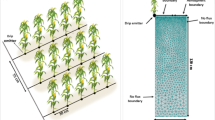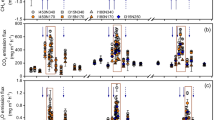Abstract
Best management practices, such as conservation tillage, the optimum level of irrigation, fertilization, are frequently used to reduce non-point source pollution from agricultural land and improve water quality. In this study, we used the soil and water assessment tool to model the impacts of different irrigation (adjusted to crop need), cropping and fertilization practices on total nitrogen loss. The economic impacts of these practices on crop net farm income were also evaluated. For this purpose, the model was calibrated through comparing model outputs with observations to ensure reliable hydrologic, crop yield and nitrate leaching simulations. The results showed that by reducing water or fertilizer or combination of both, we can reduce nitrate leaching. For wheat and corn, the best scenario was S1n1 (combination between reduction by 10 % of water and nitrogen fertilizer application, simultaneously) and S2n3 (combination of 20 and 30 % reduction in water and fertilizer application), respectively. These scenarios are both ecologically and economically desirable. Also, decreasing nitrogen fertilization by 50 % for corn would decrease the nitrate pollution from 101.1 to 32.3 kg N ha−1; therefore, this strategy is ecologically desirable but economically unsound. So, there are opportunities for environmental decision makers to encourage farmers to implement these strategies. Also, since the nitrogen leaching cannot decrease without a reduction in net farm income for crops such as corn; hence, the losses of farmers should be compensated.







Similar content being viewed by others
Notes
Environmental Costing Model.
Sequential Uncertainty Fitting, ver. 2.
SWAT Calibration Uncertainty Procedures.
Generalized Likelihood Uncertainty Estimation.
Parameter Solution.
Monte Carlo Markov Chain.
References
Aarts, H. F. M., Habekotte, B., & Van Keulen, H. (2000). Ground water recharge through optimized intensive dairy farms. Journal of Environmental Quality, 29, 738–743.
Abbaspour, K. C., Yang, J., Maximov, I., Siber, R., Bogner, K., Mieleitner, J., et al. (2007). Modelling hydrology and water quality in the prealpine/alpine Thur watershed using SWAT. Journal of Hydrology, 333(2–4), 413–430.
Ahmadzadeh, H., Morid, S., Delavar, M., & Srincasan, R. (2015). Using the SWAT model to assess the impacts of changing irrigation from surface to pressurized systems on water productivity and water saving in the Zarrineh Rud catchment. Journal of Agricultural Water Management, 175, 15–28.
Akhavan, S., Abedi-Koupai, J., Mousavi, S. F., Afyuni, M., Eslamian, S. S., & Abbaspour, K. C. (2010). Application of SWAT model to investigate nitrate leaching in Hamadan-Bahar Watershed, Iran. Journal of Agriculture, Ecosystems and Environment, 139, 675–688.
Arnold, J. G., Srinivasan, R., Muttiah, R. S., & Williams, J. R. (1998). Large area hydrologic modelling and assessment part I: model development. Journal of American Water Resources Association, 34(1), 73–89.
Behrendt, H., Ley, M., Korol, R., Stronska-Kedzia, M., & Pagenkopf, W. (1999). Point and diffuse nutrient emissions and transports in the Odra Basin and its main tributaries. Acta hydrochimica et hydrobiologica, 27, 274–281.
Beven, K., & Binley, A. (1992). The future of distributed models—model calibration and uncertainty prediction. Hydrological Processes, 6, 279–298.
Bossa, A. Y., Diekkrüger, B., Igué, A. M., & Gaiser, T. (2012). Analyzing the effects of different soil databases on modelling of hydrological processes and sediment yield. Geoderma, 173–174, 61–74.
Bouraoui, F., & Grizzetti, B. (2008). An integrated modelling framework to estimate the fate of nutrients: Application to the Loire (France). Ecological Modelling, 212, 450–459.
Conijn, J. G., & Henstra, P. 2003. Effecten van bemestingsstrategiee¨n op grasopbrengsten en stikstofverliezen onder gemaaid grasland. Een simulatiestudie. Rapport 66. Plant Research International, Wageningen, The Netherlands, 48 pp (in Dutch).
Cools, J., Broekx, S., Vandenberghe, V., Sels, H., Meynaerts, E., Vercaemst, P., et al. (2011). Coupling a hydrological water quality model and an economic optimization model to set up a cost-effective emission reduction scenario for nitrogen. Environmental Modelling and Software, 26, 44–51.
Daroub, S. H., Van Horn, S., Lang, T. A., & Diaz, O. A. (2011). Best management practices and long-term water quality trends in the everglades agricultural area. Critical Reviews in Environmental Science and Technology, 41(1), 608–632.
Faramarzi, M., Abbaspour, K. C., Schulin, R., & Yang, H. (2009). Modelling blue and green water resources availability in Iran. Hydrological Processes, 23, 486–501.
Fohrer, N., Haverkamp, S., & Frede, H. G. (2005). Assessment of the effects of land-use patterns on hydrologic landscape functions: Development of sustainable land-use concepts for low mountain range areas. Hydrological Processes, 19, 659–672.
Holvoet, K., van Griensven, A., Seuntjens, P., & Vanrolleghem, P. A. (2005). Sensitivity analysis for hydrology and pesticide supply towards the river in SWAT. Physics and Chemistry of the Earth, 30, 518–526.
Inamdar, S. P., Mostaghimi, S., McClellan, P. W., & Brannan, K. M. (2001). BMP impacts on sediment and nutrient yields from an agricultural watershed in the coastal plain region. Transactions of the American Society of Agricultural Engineering, 44(5), 1191–1200.
Lam, Q. D., Schmalz, B., & Fohrer, N. (2011). The impact of agricultural best management practices on water quality in a North German lowland catchment. Environmental Monitoring Assessment, 183, 351–379.
Lenhart, T., Eckhardt, K., Fohrer, N., & Frede, H. G. (2002). Comparison of two different approaches of sensitivity analysis. Physics and Chemistry of the Earth, Parts A/B/C, 27(9), 645–654.
Moriasi, D. N., Arnold, J. G., Van Liew, M. W., Binger, R. L., Harmel, R. D., & Veith, T. (2007). Model evaluation guidelines for systematic quantification of accuracy in watershed simulations. Transactions of the American Society of Agricultural Engineering, 50(3), 885–900.
Neitsch, S. L., Arnold, J. G., Kiniry, J. R., Williams, J. R., & King, K. W. 2005. Soil and water assessment tool. In: Theoretical documentation: Version 2005. TWRI TR-191, College Station, TX.
Nguyen, T. T., Ruidisch, M., Koellner, T., & Tenhunen, J. (2014). Synergies and tradeoffs between nitrate leaching and net farm income: The case of nitrogen best management practices in South Korea. Agriculture, Ecosystems & Environment, 186, 160–169.
Nie, X. H., Huang, G. H., Wang, D., & Li, H. L. (2008). Robust optimization for inexact water quality management under uncertainty. Civil Engineering and Environmental Systems, 25(2), 167–184.
Ramanarayanan, T. S., Williams, J. R., Duglas, W. A., Hauck, L. M., & McFarland, A. M. S. 1997. Using APEX to identify alternative practices for animal waste management, ASAE International Meeting, Minneapolis, MN. Paper No. 97-2209.
Rostamian, R., Jaleh, A., Afyuni, M., Mousavi, S. F., Heidarpour, M., Jalalian, A., et al. (2008). Application of a SWAT model for estimating runoff and sediment in two mountainous basins in central Iran. Hydrological Science Journal, 53(5), 977–988.
Ruget, F., Brisson, N., Delecolle, R., & Faiver, R. (2002). Sensitivity analysis of a crop simulation model, STICS, in order to choose the main parameters to be estimated. Agronomie, 22, 133–158.
Santhi, C., Arnold, J., Williams, J., Hauck, L., & Dugas, W. (2001). Application of a watershed model to evaluate management effects on point and non-point source pollution. Transactions of the American Society of Agricultural Engineering, 44, 1559–1570.
Schuol, J., Abbaspour, K. C., Sarinivasan, R., & Yang, H. (2008a). Estimation of freshwater availability in the West African sub-continent using the SWAT hydrologic model. Journal of Hydrological, 352, 30–42.
Schuol, J., Abbaspour, K. C., Yang, H., Srinivasan, R., & Zehnder, A. J. B. (2008b). Modelling blue and green water availability in Africa. Water Resources Research, 44, 1–18.
Smukler, S. M., O’Geen, A. T., & Jackson, L. E. (2012). Assessment of best management practices for nutrient cycling: A case study on an organic farm in a Mediterranean-type climate. Journal of Soil and Water Conservation, 67(1), 16–31.
Sun, C., & Ren, L. (2014). Assessing crop yield and crop water productivity and optimizing irrigation scheduling of winter wheat and summer maize in the Haihe plain using SWAT model. Journal of Hydrological Processes, 28, 2478–2498.
Tuppad, P., Kannan, N., Srinivasan, R., Rossi, C. G., & Arnold, J. G. (2010). Simulation of agricultural management alternatives for watershed protection. Water Resources Management, 24, 3115–3144.
Vagstad, N., French, H. K., Andersen, H. E., Behrendt, H., Grizzetti, B., Groenendijk, P., et al. (2009). Comparative study of model prediction of diffuse nutrient losses in response to changes in agricultural practices. Journal of Environmental Monitoring, 11, 594–601.
Van Griensven, A., & Meixner, T. (2006). Methods to quantify and identify the sources of uncertainty for river basin water quality models. Water Science and Technology, 53, 51–59.
Vrugt, J. A., Gupta, H. V., Bouten, W., & Sorooshian, S. (2003). A shuffled complex evolution metropolis algorithm for optimization and uncertainty assessment of hydrologic model parameters. Water Resource Research, 39(8), 1–18.
Wang, X., Williams, J. R., Izaurralde, R. C., & Atwood, J. D. (2005). Sensitivity and uncertainty analysis of crop yields and soil organic carbon simulated with EPIC. Transactions of the ASAE, 48, 1041–1054.
White, K. L., & Chaubey, I. (2005). Sensitivity analysis, calibration, and validations for a multisite and multivariable SWAT model. Journal of the American Water Resources Association, 41, 1077–1089.
Xu, Z. X., Pang, J. P., Liu, C. M., & Li, J. Y. (2009). Assessment of runoff and sediment yield in the Miyun Reservoir catchment by using SWAT model. Hydrological Processes, 23, 3619–3630.
Yang, J., Reichert, P., Abbaspour, K. C., Xia, J., & Yang, H. (2008). Comparing uncertainty analysis techniques for a SWAT application to Chaohe Basin in China. Journal of Hydrological, 358, 1–23.
Ziaei, A., & Sepaskhah, A. R. (2003). Model for simulation of winter wheat yield under dry land and irrigated conditions. Agricultural Water Management, 58, 1–17.
Acknowledgments
The authors are grateful to M. Faramarzi and K. Abbaspour from Swiss Federal Institute of Aquatic Science and Technology (Eawag) for providing assistance to conduct this study.
Author information
Authors and Affiliations
Corresponding author
Rights and permissions
About this article
Cite this article
Sheikhzeinoddin, A., Esmaeili, A. Ecological and economic impacts of different irrigation and fertilization practices: case study of a watershed in the southern Iran. Environ Dev Sustain 19, 2499–2515 (2017). https://doi.org/10.1007/s10668-016-9868-6
Received:
Accepted:
Published:
Issue Date:
DOI: https://doi.org/10.1007/s10668-016-9868-6




